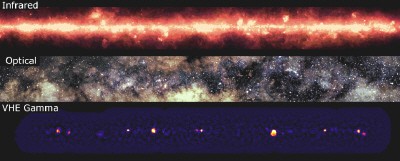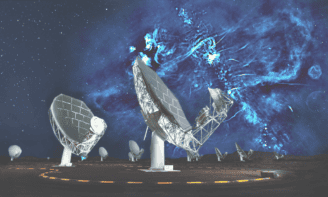Eight new sources of very high energy gamma rays have been found in the centre of our galaxy, including two "dark" sources that have never been seen before at other wavelengths. The discovery was made by an international team of astrophysicists who used the HESS array of telescopes in Namibia in Africa to conduct the most sensitive ever survey of the Milky Way at such short wavelengths (F Aharonian et al. 2005 Science 307 1938). The results could help shed more light on the origins of cosmic rays in the universe.

Cosmic rays are high-energy particles from outer space that continually bombard the Earth. Although they were first detected in 1912, astrophysicists still don’t know where the most energetic cosmic rays come from or how they are accelerated to such high energies. However, the acceleration of cosmic rays and the production of very high energy gamma-rays are thought to be connected.
Very high energy gamma rays have energies of 1011 eV or more and are thought to be produced by supernovae explosions, pulsars, quasars and massive star forming regions. However, these rays are quite rare and strike the Earth’s atmosphere only about once per month per square metre. The High Energy Stereoscopic System (HESS) measures the Cerenkov radiation — short flashes of blue light — that is produced when the gamma rays are absorbed in the air. This light is collected by the four telescopes in HESS and is then used to create images of astronomical objects as they appear in gamma rays (see figure).
Of the eight sources detected, at least two have no counterparts at radio, optical or X-ray wavelengths. According to the team, these sources could be a new class of “dark” cosmic accelerators. Moreover, the main particles accelerated in these objects are nucleons rather than electrons as in the more conventional sources.
“We have added a new part to the multiwavelength picture of the Milky Way,” team member Stefan Funk told PhysicsWeb. “This information from a new wavelength regime should spark activity in other wavebands such as X-ray and radio to better understand the processes at work in these new sources.” The HESS collaboration now plans to survey other parts of the galaxy.



